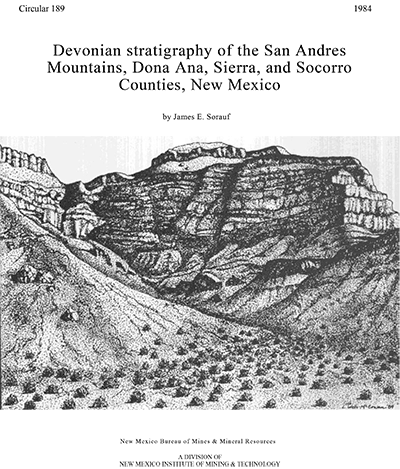
Circular 189—Devonian stratigraphy of the San Andres Mountains, Doña Ana, Sierra, and Socorro Counties, New Mexico
By J. E. Sorauf, 1984, 32 pp., 1 table, 36 figs., 1 appendix.

Devonian stratigraphic
relationships are described from 16 localities in the San Andres Mountains,
Mud Springs Mountains, and at Hermosa, New Mexico. Devonian strata in the
San Andres Mountains comprise a thin (25–50 m or 60–170 ft), unconformity-bounded
sequence, commonly with diastemic formation or member boundaries. The formations
recognized throughout most of the area are the Oñate, Sly Gap, and
Contadero Formations of Givetian, Frasnian, and Famennian ages, respectively.
The setting during Devonian time was a shelf area characterized by calcareous,
argillaceous, and sandy sediments, grading into dark basinal shales at the
south end of the range. Over most of the area, the Oñate Formation
is characterized by brown, silty, dolomitic rocks overlain by shales and
argillaceous limestones of the Sly Gap Formation. The overlying Contadero
Formation, mostly consisting of shales and fine sandstones, can be subdivided
into members in the northernmost quarter of the area. These units are the
basal Salinas Peak member, the middle Thurgood Sandstone Member, and the
upper Rhodes Canyon Member of interbedded tan shale and sandstone. These
units cannot be identified south of Cottonwood Canyon, and the Sly Gap and
Contadero Formations can be differentiated only as far south as San Andres
Canyon. South of San Andres Canyon, dark shales comprise the Devonian rocks
above much-thinned Oñate Formation dolomites.
All units are fossiliferous, with excellent brachiopod faunas providing
ages of each. Corals that are present throughout the Frasnian part of the
section are extremely rare in older rocks and absent in the Famennian rocks.
Faunal elements are recognizable to the west in outcrops examined at the
Mud Springs Mountains and at Hermosa, New Mexico. Both the Oñate
and Slay Gap beds are demonstrably present to the west, and at Hermosa they
occur beneath typical Percha Shale.
$6.00
Buy
Now
Also available as a free download.
Download
| File Name | Size | Last Modified |
|---|---|---|
| Circular-189.pdf | 2.87 MB | 01/11/2021 03:43:09 PM |



